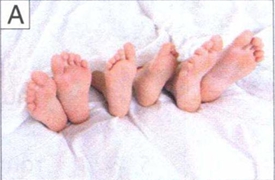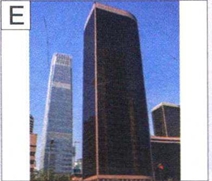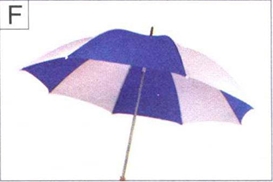热身 Warm – up
1 给下面的词语选择对应的图片 Match the pictures with the words.
 B
B C
C D
D E
E F
F
- sǎn 伞 ________
- jīng lǐ 经理 ________
- bàn gōng shì 办公室 ________
- jiǎo 脚 ________
- lóu 楼 ________
- shù 树 ________
2 说说你做完这些事以后做什么 Talk about what you are going to do after you finish doing each thing in Column Ⅴ₁.
| V₁ | V₂ |
|---|---|
| 例:起床 qǐ chuáng | 吃早饭 chī zǎofàn |
| 吃饭 chī fàn | |
| 写作业 xiě zuòyè | |
| 下课 xià kè | |
| 运动 yùndòng | |
| 回家 huí jiā |
课文 Texts
1 下山的路上 On the way going down the mountain
小丽:休息一下吧。
小刚:怎么了?
小丽:我现在腿也疼,脚也疼。
小刚:好,那边树多,我们过去坐一下吧。
小丽:上来的时候我怎么没觉得这么累?
小刚:上山容易下山难,你不知道?
1. 腿 tuǐ n. leg
2. 疼 téng adj. hurt, painful
3. 脚 jiǎo n. foot
4. 树 shù n. tree
5. 容易 róngyì adj. easy
6. 难 nán adj. difficult
2 在打电话 On the phone
周太太:喂,你好,请问周明在吗?
秘书:周经理出去了,不在办公室。
周太太:他去哪儿了?什么时候回来?
秘书:他出去办事了,下午回来。
周太太:回来了就让他给我打个电话。
秘书:好的,他到了办公室我就告诉他。
*7. 太太 tàitai n. Mrs., madam
*8. 秘书 mìshū n. secretary
9. 经理 jīnglǐ n. manager
10. 办公室 bàngōngshì n. office
1. 周 Zhōu Zhou, a surname
2. 周明 Zhōu Míng Zhou Ming, name of a person
3 在楼门口送朋友 Parting at the exit of the building
小刚:雨下得真大。你怎么回去?我送你吧。
小丽:没事,我出去叫辆出租车就行了。
小刚:那你等等,我上楼去给你拿把伞。
小丽:好的。我跟你一起上去吧。
小刚:你在这儿等吧,我拿了伞就下来。
11. 辆 liàng m. used for vehicles
12. 楼 lóu n. building
13. 拿 ná v. to take, to fetch
14. 把 bǎ m. used for things with a handle
15. 伞 sǎn n. umbrella
在家 At home
周太太:你看,我这么胖,怎么办呢?
周 明:你每天晚上吃了饭就睡觉,也不出去走走,能不胖吗?
周太太:其实我每天都运动。
周 明:但是你一点儿也没瘦!你做什么运动了?
周太太:做饭啊。
生词 New Words
16. 胖 pàng adj. fat
17. 其实 qíshí adv. actually
18. 瘦 shòu adj. thin
拼音课文 Texts in Pinyin
Xià shān de lùshang
Xiǎoli: Xiuxi yíxià ba.
Xiǎogāng: Zěnme le?
Xiǎoli: Wǒ xiànzài tuǐ yě téng, jiǎo yě téng.
Xiǎogāng: Hǎo, nàbian shù duō, wǒmen guoqu zuò yíxià ba.
Xiǎoli: Shànglai de shíhou wǒ zěnme méi juéde zhème lèi?
Xiǎogāng: Shàng shān róngyì xià shān nán, nǐ zhīdào ma?
Zài dǎ diànhuà
Zhōu tàitai: Wèi, nǐ hǎo, qǐngwèn Zhōu Míng zài ma?
mìshū: Wǒmen jīnglǐ chūqù le, bú zài bàngōngshì.
Zhōu tàitai: Tā qù nǎr le? Shénme shíhou huílai?
mìshū: Tā chūqu bàn shì le, xiàwǔ huílai.
Zhōu tàitai: Huílai le jiù ràng tā gěi wǒ dǎ ge diànhuà.
mìshū: Hǎo de, tā dàole bàngōngshì wǒ jiù gàosu tā.
Zài lóu ménkǒu sòng péngyou
Xiǎogāng: Yǔ xià de zhèn dà. Nǐ zěnme huíqu? Wǒ sòng nǐ ba.
Xiǎoli: Méi shì, wǒ chūqu jiào liàng chūzūchē jiù xíng le.
Xiǎogāng: Nà nǐ děngdeng, wǒ shàng lóu qù gěi nǐ ná bǎ sǎn.
Xiǎoli: Hǎo de. Wǒ gēn nǐ yìqǐ shàngqù ba.
Xiǎogāng: Nǐ zài zhèr děng ba, wǒ nàle sǎn jiù xiàlái.
Zài jiā
Zhōu tàitai: Nǐ kàn, wǒ zhème pàng, zěnme bàn ne?
Zhōu Míng: Nǐ měi tiān wǎnshang chīle fàn jiù shuì jiào, yě bù chūqu zǒuzou, néng bú pàng ma?
Zhōu tàitai: Qíshí wǒ měi tiān dōu yùndòng.
Zhōu Míng: Dànshì nǐ yìdiǎn er yě méi shòu! Nǐ zuò shénme yùndòng le?
Zhōu tàitai: Zuò fàn a.
注释 Notes
1 简单趋向补语 Simple Complements of Direction
汉语中 “V+来/去” 表示动作的方向,“来” 表示朝着说话人的方向,“去” 表示背离说话人的方向。最常用的动词有 “上、下、进、出、回、过、起”,我们学过的动词还有 “买、带、搬”。例如:
In Chinese, “V + 来/去” indicates the direction of an action, with “来” indicating the direction towards the speaker and “去” the direction away from the speaker. The most frequently used verbs include “上”,”下”,”进”,”出”,”回”,”过” and “起” as well as some verbs we’ve learned, such as “买”,”带” and “搬”. For example:
- 我们在楼上等你呢,你上来吧。(说话的人在楼上)
- 谁在外边?你出去看看吧。(“你” 在屋里)
- 汉语书你带来了吗?
- 那边树多,我们过去坐一下吧。
如果宾语是地点名词,要放在 “来/去” 的前边。例如:
If the object is a place, it should precede “来/去”. For example:
- 小狗下楼来吃东西。
- 老师进教室来上课。
- 朋友回家去了。
- 我上楼去。
如果宾语是事物名词,可以放在 “来/去” 的前边,也可以放在 “来/去” 的后边。例如:
If the object is a thing, it can be put before or after “来/去”. For example:
- 明天要带作业来。
- 帮我买来点儿面包。
- 你搬这把椅子去吧。
- 这次旅游,我想带去这本书。
练一练 Practise
完成句子 Complete the sentences.
- 你怎么还没________?我都在楼下等你半小时了。
- 已经10点半了,快点儿________,别睡了。
- 明天去朋友家,我想________一些水果。
2 两个动作连续发生 The Successive Occurrence of Two Actions
汉语中可以用 “V₁了……就V₂……” 表示两个动作连续发生,后边的动作紧接着前边的动作。例如:
In Chinese, “V₁了……就V₂……” can be used to indicate two actions which occur successively, with the second immediately following the first. For example:
- 我下了课就吃饭。
- 妈妈起了床就做早饭。
- 小刚拿了伞就下来。
- 你每天晚上吃了饭就睡觉。
如果句子中有两个主语,那么第二个主语要放在“就”前边。例如:
In a sentence with two subjects, the second subject should be put right before “就”.
For example:
- 你下了课我们就去书店。
- 老师进了教室我们就对她说“生日快乐”。
- 爸爸回来了我们就吃饭。
- 他到了办公室我就告诉他。
练一练 Practise
完成对话 Complete the dialogues.
-
A: 你什么时候给妈妈打电话?
B: 我打算____________________。(吃晚饭)
-
A: 你怎么____________________?(到家、睡觉)
B: 我太累了。
-
A: 你什么时候走?
B: 他来了____________________。
3 反问的表达:能……吗? The Rhetoric Question “能……吗?”
汉语中可以用“能……吗”表示反问,“能……吗”中间如果是肯定形式,表达的就是否定的意思,如果是否定的形式,表达的就是肯定的意思。
例如:
“能……吗” is used in a rhetorical question in Chinese, with its positive form meaning the negative and the negative form meaning the positive. For example:
-
A: 为什么我的汉语学得不好?
B: 你不做作业,也不练习,能学好吗?(不能学好)
-
A: 你看我这么胖,怎么办呢?
B: 你每天晚上吃了饭就睡觉,也不出去走走,能不胖吗?(会胖)
B: 你今天爬山爬得那么快,____________________?
B: 天气这么冷,你穿得这么少,____________________?
B: 我每天都练习,____________________?

Comments